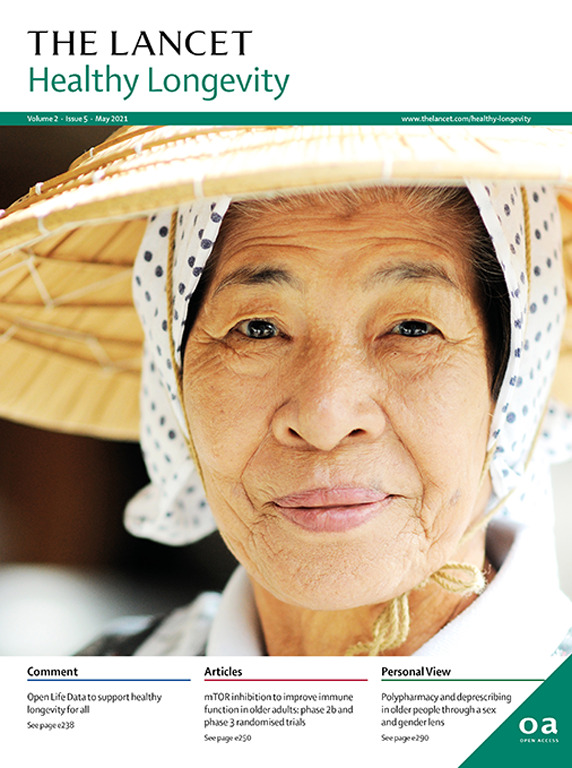英国所有成年人的住院时间、住院死亡率和住院费用与医院虚弱风险评分之间的关系:一项具有全国代表性的回顾性观察性队列研究
IF 14.6
Q1 GERIATRICS & GERONTOLOGY
引用次数: 0
摘要
背景:研究表明,医院虚弱风险评分(HFRS)与75岁及以上人群的住院时间、住院死亡率和费用显著相关。然而,它是否适用于所有年龄段的住院成年人尚不清楚。我们的目的是在全国代表性的18岁及以上接受紧急医院护理的成年人样本中检查HFRS与这三个结果之间的关系。方法:分析样本包括2011年4月1日至2019年3月31日期间所有18岁及以上的英国国家卫生服务急性医院急诊入院患者的5%,即1478 554例急诊入院患者,共653 294例患者。入院者被分为零(HFRS=0)、低(0< HFRS 15)虚弱风险组。我们分析了这些类别与三个结局之间的关系:住院时间(泊松模型)、院内死亡(probit模型);医院费用(广义线性模型)。模型控制了患者特征和时间效应,分别在9个年龄组(18-24岁、25-34岁、35-44岁、45-54岁、55-64岁、65-74岁、75-84岁、85-94岁和≥95岁)中运行。结果:高衰弱风险患病率随年龄增长而增加,18-24岁住院患者96 296例中210例(0.2%),95岁及以上住院患者22 431例中9414例(42.0%)。在所有年龄组中,虚弱风险与住院时间和费用之间存在显著关联;这种关联的程度随着年龄的增长而增加。例如,对于那些年龄在18-24岁、脆弱风险高的人来说,住院时间比零脆弱风险的人长4.5天(95% CI 3.8 - 5.3),费用高出1217英镑(796-1638)。对于95岁及以上的高衰弱风险患者,住院时间比零衰弱风险患者长15.3天(13.5 - 17.1天),费用高出2557英镑(2234-2880英镑)。衰弱风险与院内死亡率之间的关联在65-74岁之间增加,该年龄组中衰弱风险高的患者在院内死亡的概率比无衰弱风险的患者高2.3%(1.99 - 2.61)。这种关联在年龄较大的群体中有所下降。解释:虽然是为75岁及以上的人群设计的,但HFRS与所有住院成年人的住院时间、住院死亡和住院费用显著相关,且随着年龄的增长,影响程度更大。使用老年人HFRS的脆弱性仪表板可以扩展到所有18岁及以上的人,从而为年轻人提供针对脆弱性的整体干预措施,例如早期生命过程干预措施,以延迟或预防脆弱性及相关后果。资助:国家卫生和保健研究所。本文章由计算机程序翻译,如有差异,请以英文原文为准。
Association between Hospital Frailty Risk Score and length of hospital stay, hospital mortality, and hospital costs for all adults in England: a nationally representative, retrospective, observational cohort study
Background
Studies have shown that the Hospital Frailty Risk Score (HFRS) is significantly associated with length of stay, in-hospital mortality, and costs in people aged 75 years and older. However, its applicability to hospitalised adults of all ages is unclear. We aimed to examine the association between the HFRS and these three outcomes in a nationally representative sample of adults aged 18 years and older, admitted for emergency hospital care.
Methods
The analytical sample comprised 1 478 554 emergency hospital admissions for 653 294 patients—a 5% random sample of all emergency admissions for those aged 18 years and older to any English National Health Service acute hospital between April 1, 2011, and March 31, 2019. Admissions were categorised into zero (HFRS=0), low (0< HFRS <5), intermediate (5≤ HFRS ≤15), or high (HFRS >15) frailty risk categories. We analysed the association between these categories and three outcomes: length of stay (Poisson model), in-hospital death (probit model); and hospital costs (generalised linear model). Models controlled for patient characteristics and temporal effects and were run separately across nine age groups (18–24 years, 25–34 years, 35–44 years, 45–54 years, 55–64 years, 65–74 years, 75–84 years, 85–94 years, and ≥95 years).
Findings
The prevalence of high frailty risk increased with age, from 210 (0·2%) of 96 296 admissions for those aged 18–24 years to 9414 (42·0%) of 22 431 admissions for those aged 95 years and older. There were significant associations between frailty risk and both length of stay and costs across all age groups; the magnitude of the associations increased with age. For example, for those aged 18–24 years with high frailty risk, length of stay was 4·5 days (95% CI 3·8–5·3) longer and costs were £1217 higher (796–1638) than for someone with a zero frailty risk. For those aged 95 years and older with high frailty risk, length of stay was 15·3 days (13·5–17·1) longer and costs were £2557 higher (2234–2880) than for someone with a zero frailty risk. The association between frailty risk and in-hospital mortality increased up to age 65–74 years—those in this age group with high frailty risk had a probability of dying in hospital that was 2·3% greater (1·99–2·61) than those with zero frailty risk. This association decreased for older age groups.
Interpretation
Although designed for people aged 75 years and older, the HFRS was significantly associated with length of stay, in-hospital death, and hospital costs for all adults admitted to hospital, with a greater magnitude of effect with increasing age. Frailty dashboards that use the HFRS for older people could be extended to all people aged 18 years and older, offering the potential for holistic, frailty attuned interventions for younger people, such as earlier life course interventions to delay or prevent frailty and related outcomes.
Funding
National Institute for Health and Care Research.
求助全文
通过发布文献求助,成功后即可免费获取论文全文。
去求助
来源期刊

Lancet Healthy Longevity
GERIATRICS & GERONTOLOGY-
CiteScore
16.30
自引率
2.30%
发文量
192
审稿时长
12 weeks
期刊介绍:
The Lancet Healthy Longevity, a gold open-access journal, focuses on clinically-relevant longevity and healthy aging research. It covers early-stage clinical research on aging mechanisms, epidemiological studies, and societal research on changing populations. The journal includes clinical trials across disciplines, particularly in gerontology and age-specific clinical guidelines. In line with the Lancet family tradition, it advocates for the rights of all to healthy lives, emphasizing original research likely to impact clinical practice or thinking. Clinical and policy reviews also contribute to shaping the discourse in this rapidly growing discipline.
 求助内容:
求助内容: 应助结果提醒方式:
应助结果提醒方式:


